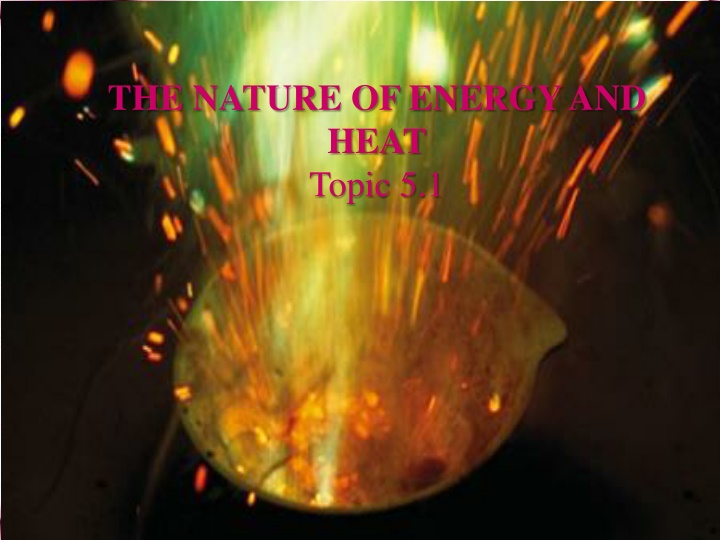
Energy and Thermodynamics Concepts
Explore the nature of energy and heat, delve into thermochecmistry, learn about the law of conservation of energy, understand systems and surroundings in thermodynamics, grasp the concept of different types of systems, discover the significance of heat transfer, and familiarize yourself with units of energy measurement.
Download Presentation

Please find below an Image/Link to download the presentation.
The content on the website is provided AS IS for your information and personal use only. It may not be sold, licensed, or shared on other websites without obtaining consent from the author. If you encounter any issues during the download, it is possible that the publisher has removed the file from their server.
You are allowed to download the files provided on this website for personal or commercial use, subject to the condition that they are used lawfully. All files are the property of their respective owners.
The content on the website is provided AS IS for your information and personal use only. It may not be sold, licensed, or shared on other websites without obtaining consent from the author.
E N D
Presentation Transcript
http://s-college.cengage.com/nextbook/vining/vining_owlbook_prototype/ebook/images/book_content/05-15.jpghttp://s-college.cengage.com/nextbook/vining/vining_owlbook_prototype/ebook/images/book_content/05-15.jpg THE NATURE OF ENERGY AND HEAT Topic 5.1
THERMOCHEMISTRY The study of heat released or required by chemical reactions Fuel is burnt to produce energy - combustion CH4(g) + 2O2(g) CO2(g) + 2H2O(l) + energy
Law of Conservation of Energy The total energy of the universe is constant and can neither be created nor destroyed; it can only be transformed. Energy is a measure of the ability to do work, that is to move an object against an opposing force. It comes in many forms: heat, light, sound electricity and chemical energy
Systems & Surroundings In thermodynamics, the world is divided into a system and its surroundings A system is the part of the world we want to study (e.g. a reaction mixture in a flask) The surroundings consist of everything else outside the system SYSTEM OPEN ISOLATED CLOSED
OPEN SYSTEM: can exchange both matter and energy with the surroundings (e.g. open reaction flask, rocket engine) CLOSED SYSTEM: can exchange only energy with the surroundings (matter remains fixed) e.g. a sealed reaction flask ISOLATED SYSTEM: can exchange neither energy nor matter with its surroundings (e.g. a thermos flask)
HEAT HEAT (q) is the energy that transfers from one object to another when the two objects are at different temperatures and in some kind of contact e.g. kettle heats on a gas flame cup of tea cools down (loses energy as heat) Thermal energy: random molecular motion causes heat energy -Heat also stimulates motion Temperature: average kinetic energy of an objects particles
UNITS OF ENERGY S.I. unit of energy is the joule (J) Heat and work ( energy in transit) also measured in joules 1 kJ (kilojoule) = 1000J Calorie (cal): 1 cal is the energy needed to raise the temperature of 1g of water by 1oC 1 cal = 4.184 J
ENTHALPY (H) (comes from Greek for heat inside ) The heat supplied is equal to the change in another thermodynamic property called enthalpy (H) i.e. Hsystem = +\- q H enthalpy change, the energy absorb or released to the surroundings when a system changes from reactants to products this relation is only valid at constant pressure
The standard conditions for enthalpy changes(H) are: 298 K (25oC) 100kPa 1 mol dm-3 all substances in their standard states
Enthalpy Change, H H = Hfinal - Hinitial heat in products heat in reactants Heat released or absorbed
for example... CH4(g) + 2 O2(g) CO2(g) + 2 H2O(g) H = -890.3 kJ/mol reactants products + heat i.e. less H in products than reactants i.e. heat is released!!!
for example... HgO(s) Hg(l) + O2(g) H = +90.83 kJ/mol i.e. more H in products than reactants i.e. heat is absorbed!!!
First Law of Thermodynamics: the internal energy of an isolated system is constant Signs (+/-) will tell you if energy is entering or leaving a system + indicates energy enters a system - indicates energy leaves a system
Heats of reaction and calorimetry Thermal energy Calorimetry: The process of measuring energy changes in a system Chemical energy Exothermic and Endothermic reactions Heat of reaction
https://encrypted-tbn3.gstatic.com/images?q=tbn:ANd9GcRz2zfDci_8995p1IrMIlHibCBoIUMWD_MpRhgWB8xqCfsRavFNhttps://encrypted-tbn3.gstatic.com/images?q=tbn:ANd9GcRz2zfDci_8995p1IrMIlHibCBoIUMWD_MpRhgWB8xqCfsRavFN
EXOTHERMIC & ENDOTHERMIC REACTIONS Exothermic process: a change (e.g. a chemical reaction) that releases heat. - Given a negative sign (-) A release of heat corresponds to a decrease in enthalpy Exothermic process: H < 0 (at constant pressure)
a: An exothermic reaction. The reactants are mixed At room temperature, but the temperature of the mixture rises to 40. 5 C. 40.5 CaO(s) + H2O(l) Ca(OH)2(s) a
Endothermic process: a change (e.g. a chemical reaction) that requires (or absorbs) heat. - Given a positive sign An input of heat corresponds to an increase in enthalpy Endothermic process: H > 0 (at constant pressure)
b: An endothermic reaction. The reactants are mixed At room temperature, but the temperature of the mixture falls to 5.8 C. 5.8 b Ba(OH)2 8H2O(s)(s) BaCl2 2H2O(s) + 2NH3(aq)+ 8H2O(l)
Measuring Heat Temperature is the average kinetic energy of the particles in a sample of matter Exothermic reaction, heat given off & temperature of water rises reaction Endothermic reaction, heat taken in & temperature of water drops reaction
How do we relate change in temp. to the energy transferred? Heat capacity (J/K) = heat supplied (J) temperature (K) Specific heat capacity (c), is the quantity of energy required to change the temperature of a unit of mass by 1oC (1K) more heat is required to raise the temp. of a large sample of a substance by 1oC than is needed for a smaller sample
Specific Heat Capacity (c) Heat capacity = Mass J /g /K J /K = g
Specific Heat Capacity, c input of q mass = m Temperature change = T
Specific Heat Capacity, c q (J g-1oC-1) c = m T for water, c = 4.18 J g-1oC-1
To determine the amount of heat a substance produces or absorbs we often use q = cm T q: heat in J, c: specific heat capacity in J/(g C), m: mass in g, T: temperature change in C , This equation makes sense if you consider units J x g x C J = g C
for example, Find q for the reaction C(diamond) + O2(g) CO2(g) if Ti = 20.00oC, Tf = 21.26oC, for a 0.250 g sample of diamond, with m = 1560 g H2O
solution... q = mc T = 1560 g x 4.18 J oC-1 g-1 x (21.26 - 20.00) oC = 8.22 x 103 J = 8.22 kJ






















